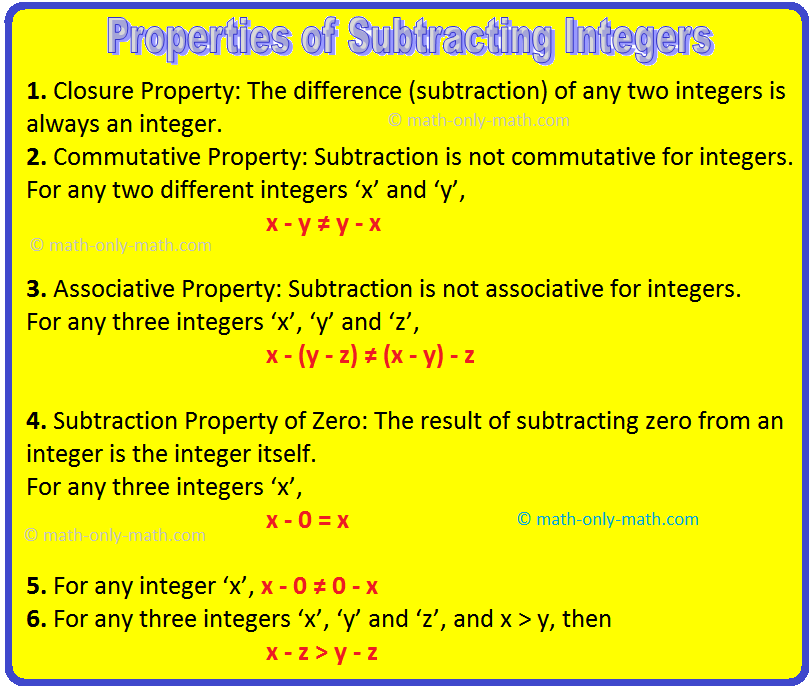Subscribe to our ▶️ YouTube channel 🔴 for the latest videos, updates, and tips.
Properties of Subtracting Integers
The properties of subtracting integers are explained here along with the examples.
1. Closure Property: The difference (subtraction) of any two integers is always an integer.
i.e., The difference of two integers is always an integer.
Hence, integers are closed under subtraction.
If x and y are any two integers, then x - y always an integer
For Examples:
(i) (+7) – (+4) = 7 - 4 = 3, which is an integer.
(ii) (-8) – (+3) = -8 – 3 = -11, which is an integer.
(iii) 6 - 14 = 6 + (-14) = - 8, which is an integer.
(iv) (- 18) - 10 = (- 18) + (- 10) = - 28, which is an integer.
2. Commutative Property: Subtraction is not commutative for integers.
For any two different integers ‘x’ and ‘y’,
x - y ≠ y - x
For Examples:
(i) 4 - 8 = 4 + (-8) = -4 and 8 - 4 = 8 + (- 4) = 4
Therefore, 4 - 8 ≠ 8 - 4
(ii) (- 4) - 7 = (- 4) + (- 7) = - 11 and 7 - (-4) = 7 + 4 = 11
Therefore, (- 4) - 7 ≠ 7 - (-4)
3. Associative Property: Subtraction is not associative for integers.
For any three integers ‘x’, ‘y’ and ‘z’,
x - (y - z) ≠ (x - y) - z
For Example:
[2 - (- 3)] - (- 6) = [2 + (3)] + 6 = 5 + 6 = 11 and
2 - [(- 3) - (- 6)] = 2 - [(- 3) + 6] = 2 - 3 = -1
Therefore, [2 - (- 3)] - (- 6) ≠ 2 - [(- 3) - (- 6)]
4. Subtraction Property of Zero: The result of subtracting zero from an integer is the integer itself.
For any three integers ‘x’,
x - 0 = x
For Example:
(i) 5 - 0 = 5
(ii) 8 - 0 = 8
(iii) 100 - 0 = 100
(iv) 9999 - 0 = 9999
(v) 99999999 - 0 = 99999999
5. For any integer ‘x’, x - 0 ≠ 0 - x
For Example:
(i) 7 - 0 = 7 and 0 - 7 = -7
Therefore, 7 - 0 ≠ 0 - 7
(ii) 10 - 0 = 10 and 0 - 10 = -10
Therefore, 10 - 0 ≠ 0 - 10
6. For any three integers ‘x’, ‘y’ and ‘z’, and x > y, then
x - z > y - z
To evaluate an expression containing various integers with plus and
minus sign:
1. Evaluate:
(i) (+15) + (-11) - (+5) - (-7)
= 15 - 11 - 5 + 7
= 22 – 16, [Adding all integers with plus (+) sign together and with minus (-) sign respectively together]
= +6 or simply 6.
(ii) (-72) + (-93) - (-85) + (+78)
= -72 -93 + 85 + 78
= -165 + 163, [Adding all integers with plus (+) sign together and with minus (-) sign respectively together]
= - 2
2. Evaluate the expression (-45) + (-32) – (-69) + (87)
Solution:
(-45) + (-32) – (-69) + (87)
= -45 – 32 + 69 +87
Add all the positive terms and add all the negative terms
= -(45 + 32) + (69 + 87)
= -77 + 156
= +79
= 79
3. Simplify: 32 – 13 + 35 + 18 - 60
Solution:
32 – 13 + 35 + 18 – 60
Add all the positive terms and add all the negative terms
= (32 + 35 + 18) – (13 + 60)
= 85 – 73
= +12 or simply 12
4. The sum of two integers is -17. If one of them is -7, find the other.
Solution:
Other integer = Sum of two integers - the given integer
= (-17) – (-7)
= -17 + 7
= -10
Therefore the other number is -10.
6th Grade Page
From Properties of Subtracting Integers to HOME PAGE
Didn't find what you were looking for? Or want to know more information about Math Only Math. Use this Google Search to find what you need.



New! Comments
Have your say about what you just read! Leave me a comment in the box below. Ask a Question or Answer a Question.